Abstract
The construction sector is one of the most active sectors, with a high economic, environmental and social impact. For this reason, the sustainable design of structures and buildings is a trend that must be followed. Bridges are one of the most important structures in the construction sector, as their construction and maintenance are crucial to achieve and retain the best transport between different places. Nowadays, the choice of bridge design depends on the initial economic criterion but other criteria should be considered to assess the environmental and social aspects. Furthermore, for a correct choice, the influence of these criteria during the bridge life-cycle must be taken into account. This study aims to analyse the life-cycle environmental impact of efficient structures from the economic point of view. Life-cycle assessment process is used to obtain all the environmental information about bridges. In this paper, a prestressed concrete precast bridge is cost-optimized and afterwards, the life-cycle assessment is carried out to achieve the environmental information about the bridge.
1. Introduction
The basis for the definition of sustainable development lies in the Brundtland Commission’s report [1], which describes it as “development that meets the needs of the present generation without compromising the needs of the future generation”. This idea implies the consideration of different aspects of three main components: economic, environmental and social. Therefore, achieving sustainable development implies a consensus among these three main pillars, which usually have different goals. Wass et al. [2] stated that sustainable development implies that a decision-making strategy must be considered. Decision making is a process that can help to find a solution that provides a compromise between different aspects and therefore achieves a sustainable solution [3,4].
The construction sector is one of the most active sectors and one of the ones with a greater influence on the economic, environment and social aspects of the world. This indicates a need for a trend toward sustainability of buildings and structures. One of the most important structures in this sector is bridges. The construction and maintenance of bridges are crucial to generate and keep the best transport possible between different places. For this reason, the assessment of sustainable development during the whole life-cycle is necessary. Of the three main components of sustainable development, the social aspect is the least studied and there are more doubts about its assessment. On the contrary, the economic and environmental aspects have been studied more intensively and it is convenient to assume that their consideration is sufficient. Considering the evaluation of these two components to achieve sustainability of bridges, the objective is to design the bridge with the lowest cost and lowest environmental impact. Although these two pillars of sustainability have different goals, some works have stated that there is a relationship between the cost and CO2 emissions of structures [5,6]. Therefore, reducing the cost implies a reduction of CO2 emissions.
Obtaining the lowest cost or CO2 emissions have been studied by several works. Optimization algorithms are most often used to reduce the cost or CO2 emissions of structures. In some cases, this involves a mono-objective optimization of cost and CO2 emissions [5,6,7], whereas other works carry out multi-objective optimization to achieve both objectives at the same time [8,9]. Despite the relationship between cost and CO2 emissions, the environmental impact cannot be assessed by taking into account CO2 emissions alone [10]. For this reason, the environmental impact assessment must achieve a complete environmental profile. This complete environmental profile can be obtained using the life-cycle assessment (LCA) process. LCA is one of the most important and accepted methods of assessing the environmental impacts [11,12,13,14,15,16], making it an excellent tool for assessing the environmental impact of a bridge.
In this paper, a prestressed concrete precast 40 m bridge is selected as the subject of an optimization-LCA. The optimization of the cost will reduce the cost of the bridge directly and the associated CO2 emissions indirectly. This process makes it possible to obtain a cost-optimized bridge with a low environmental impact. After finishing the optimization, all the features of the cost-optimized bridge will be known, including its cost but the environmental impact will not yet have been obtained. The LCA makes it possible to obtain a complete environmental profile of this cost-optimized bridge. With this methodology, a bridge whose costs have been optimized directly and whose environmental impact has been improved is obtained and finally the LCA for the whole life-time can be performed. For this purpose, a hybrid memetic algorithm is used to carry out the cost-optimization of the bridge. Then, the Ecoinvent database [17] and the ReCiPe method [18] are used to conduct the LCA process of the bridge.
2. Optimization
The optimization process is used to achieve the best solution to a problem. This process is a clear alternative to designs based on experience. Optimization methods can be categorized into exact methods and heuristic methods. On one hand, the exact methods are based on mathematical algorithms that make it possible to obtain the global optimal solution [19]. On the other hand, the heuristic methods, which include a large number of algorithms [20], obtain an optimal solution starting from an initial solution. The exact methods are very useful in problems where there are a small number of variables, because the computing time becomes unworkable for a large number of variables. Structural optimization problems are defined for a large number of design variables and thus the heuristic method is the most useful for structural optimization. There are a large number of works that use heuristic algorithms for the optimization of different kinds of structures [8,9,21].
3. Life-Cycle Assessment
Life-cycle assessment (LCA) is one of the most important and accepted methods of evaluating the environmental impact of a product, process, or service during its whole life-cycle, taking into account all the activities involved, which are defined as inputs and outputs. The limits defined for these inputs and outputs are the boundaries of the system and represent the scheme to be considered. The LCA must be complete and thus it should consider all the activities needed for the achievement of the product, process, or service. Therefore, focusing on the construction sector, a full LCA of structures must consider all the activities from the acquisition of the raw material to the end of life. These activities associated with the whole life-cycle of the structures are grouped into the manufacturing phase, construction phase, use and maintenance phase and end of life phase. The LCA makes it possible to carry out an environmental impact assessment of a set of activities associated with the different stages of a structure’s life-cycle and the global environmental impact by adding these phases. For all that, the LCA is an excellent tool to evaluate the environmental impact of structures. ISO 14040:2006 [22] provides guidance on carrying out the LCA, divided into four steps: (1) definition of goal and scope; (2) inventory analysis; (3) impact assessment; and (4) interpretation.
The first step defines all the specifications that will be considered in the LCA. This involves other features besides the definition of the goal and scope, such as the life-cycle inventory to be taken into account, the life-cycle assessment methodology considered, the functional unit and the assumptions and limitations that have been considered in the LCA. According to the guidance defined by ISO 14040:2006 [22], the characterization defines some assumptions and limitations of the LCA that condition the following life cycle inventory and life cycle assessment. Another important feature is the functional unit that represents the unit in which the assessment will be referred.
The inventory analysis is the collection of the data needed to define the inputs and outputs that represent the system studied. This data can be obtained in different ways: from direct measurements, literature, or other sources such as databases. The most common way to obtain data is from databases.
Once these first steps have been defined, the environmental impact assessment is used to evaluate the result of the inventory analysis to obtain a set of environmental indicators that represent the environmental profile of the product, process, or service. There are different methods of representing the environmental profile. These methods can be grouped into two different approaches: midpoint and endpoint assessments. The midpoint approach defines the environmental profile by means of a set of impact categories and the endpoint approach defines the environmental profile by means of a set of damage categories. There are three damage categories (human health, resource depletion and ecosystems) into which the impact categories are clustered. Therefore, although the midpoint approach provides a complete environmental profile, it is more difficult to interpret [23]. Conversely, the endpoint approach does not provide a detailed environmental profile like the midpoint approach but is easier to understand.
Finally, the information obtained must be interpreted. For this purpose, an analysis of the different stages of life-cycle of the bridge is carried out. In addition, a study of the environmental impact of a product, process, or service can be made to improve the environmental impact associated with its activities.
4. Case Study
For the purpose of this work, a bridge is selected to carry out the optimization-LCA. First, a cost-optimization of the bridge will be carried out and then a LCA of the cost-optimized bridge will be applied to obtain a complete environmental profile. In the next points, a precise description of the bridge will be presented and then the cost-optimization and the LCA will be described in detail for the bridge described.
4.1. Bridge Description
The bridge studied is a single span prestressed concrete precast bridge of 40 m. The section of the bridge is formed by two prestressed concrete precast isostatic beams with a U-shaped cross-section. The cross-section integrates a 12 m upper reinforced concrete slab. Note that the substructure is not included in the analysis since it depends on the ground characteristics and the orography. Figure 1 shows a general view of the bridge. The bridge is located in the eastern coastal area of Spain and the environmental ambient corresponds to XC-4 according to EN 206-1 [24]. Thus, corrosion is mainly caused by carbonation.
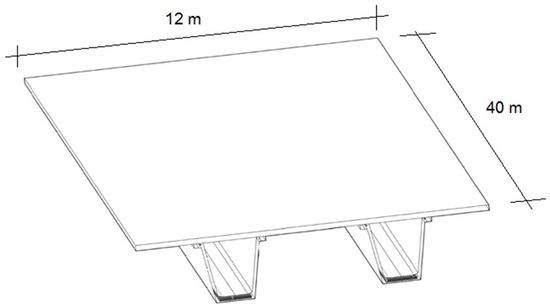
Figure 1.
General view of the prestressed concrete precast bridge.
4.2. Optimization
In this section, the cost-optimization of the prestressed concrete precast bridge will be explained. This optimization process consists in the minimization of the cost C while some restrictions gj are satisfied.
Note that x1, x2, …, xn are the design variables used for the optimization. The objective function C expresses the cost of the bridge and the restrictions gj are the serviceability limit states (SLS), the ultimate limit states (ULS), the durability limit states and the geometric and constructability constraints of the problem. There are 40 design variables, including eight variables that define the geometry of the section, two that define the concrete of the slab and the beam, four that define the prestressed steel and 26 that define the reinforcing steel. Furthermore, there are a set of parameters that have no influence on the optimization problem, such as the width, span and web inclination. Structural constraints have been considered according to the Spanish codes [25,26]. The ULSs verify if the ultimate resistance is greater than the ultimate load effect. Besides, the minimum amount of reinforcing steel for the stress requirements and the geometrical conditions are also considered. The SLSs examine different aspects. Cracking limit state requires compliance of the compression and tension cracks, as well as the decompression limit state in the area where the post-tensioned steel is located. Deflections are limited to 1/1000 of the free span length for the quasipermanent combination. In addition, the concrete and steel fatigue has been considered in this study. Table 1 summarizes of the ULSs and SLSs considered.

Table 1.
Ultimate and serviceability limit states.
In this optimization, a hybrid memetic algorithm (MA) is applied. The MA is a population-based approach to stochastic optimization that combines the parallel search used by evolutionary algorithms with a local search of the solutions forming a population [27]. Regarding the local search used, a variable-depth neighbourhood search (VDNS) is used as a variant of the very large-scale neighbourhood search (VLSN) [28]. In this MA-VDNS, a set of 500 random solutions (n) is generated as the population. Then each of these solutions is improved by means of a VDNS search to reach a local optimum. To this end, the algorithm begins by changing only one variable and when ten consecutive movements have been performed without improvement (no_imp), there will be an increase in the number of variables (var) that are changed simultaneously, up to eight. Then, with this new improved population, a genetic algorithm is applied. The genetic algorithm develops the population, which is subjected to random movements (mutations and crossovers), preserving the better adapted solutions. The cost assessment takes into account a penalty cost; nevertheless, the VDNS does not consider the penalty cost (only feasible solutions are accepted) in order to avoid the early divergence of the algorithm. The VDNS is applied to the new generation up to 150 generations. Figure 2 shows a flow chart of the hybrid memetic algorithm.
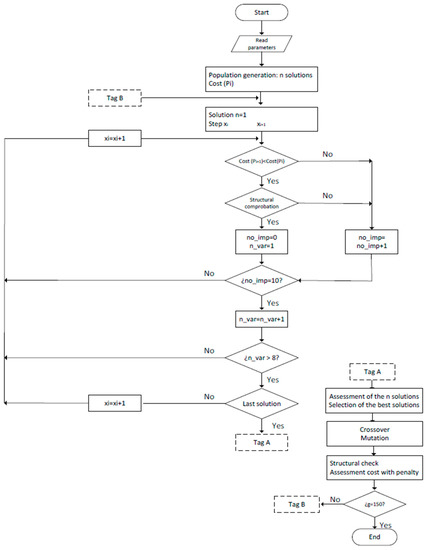
Figure 2.
Hybrid memetic algorithm flow chart.
The solution obtained for the 40 m-long prestressed concrete precast bridge has a total cost of 108,274.45 €. The geometry of this bridge is shown in Figure 3. The amount of beam concrete used is 0.1117 m3/m2, with a strength of 35 MPa, while the amount of slab concrete used is 0.1797 m3/m2, with a strength of 40 MPa. Furthermore, the precast concrete beams require 6163 kg (12.52 kg/m2) of reinforcing steel and 5184 kg (10.53 kg/m2) of prestressed steel, while the concrete slab is defined by 11,772 kg (23.92 kg/m2) of reinforcing steel.

Figure 3.
Geometry of optimized bridge.
4.3. Life-Cycle Assessment
In this section, the guidance defined by ISO 14040:2006 [22] will be applied to the bridge studied. For this purpose, the different steps will be particularized to the case of study, describing and taking into account the specific characteristics considered for this study. Figure 4 show a general view of the LCA process carried out.
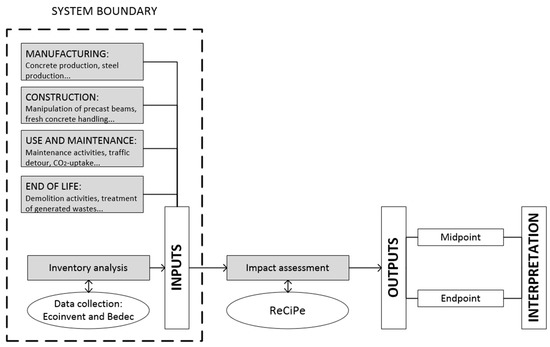
Figure 4.
General scheme LCA process.
4.3.1. Goal and Scope
The LCA will be divided into the four main phases of the whole life-cycle of the bridge for a better understanding: (1) manufacturing; (2) construction; (3) use and maintenance; and (4) end of life. Each phase will be defined separately and thus each phase will be limited by its own system boundary. The functional unit will be 1 m of the length of the bridge. The final goal is to find the environmental impact of each phase and consequently the global environmental impact of the bridge by adding the environmental impacts of different phases.
Manufacturing
The manufacturing phase includes the upstream processes of the products used in the bridge and the associated transport, from the acquisition of raw materials to materials that are ready to be used in the construction of the bridge. The prestressed concrete precast bridge has three main components: beams of precast concrete, fresh concrete and steel. Therefore, first it is necessary delimit the activities associated with each product including the transport.
On one hand, the manufacture of the beams of precast concrete takes into account all the activities from the extraction of raw materials to the finishing of the beams in the precast plant, while the manufacture of the fresh concrete for the slab takes into account the activities from the extraction of raw material to the point when the concrete is ready to be used in the construction place. In both cases, the distance considered between the quarry and the precast plant or concrete plant is 50 km, the distance considered in the cement transportation is 20 km and the distance between the concrete plant and the construction site is 50 km. Furthermore, the dosage of concrete is taken into account to achieve the strength required. On the other hand, the manufacture of the steel takes into account all the activities from the acquisition of the raw material to the point when the steel is ready to be used in the precast plant or construction site. Considering that the bridge is built in Spain, the analysis takes the Spanish steel production characteristics. This implies that 67% of the steel is produced in an electric arc furnace and the remaining 33% is produced in a basic oxygen furnace. This ratio generates a recycling rate of steel of 71%. The distance considered between the steel production plant and the precast plant or construction site is 100 km. Table 2 shows the amount of material needed for the beam and slab and the dosage of the concrete in both cases.

Table 2.
Amount of materials.
Construction
The construction phase includes all the materials and construction machinery necessary for the erection of the bridge. It includes the transportation and elevation of precast beams using special transport over 50 km. Furthermore, the bridge slab is considered to be cast in place. The construction machinery considered for the slab construction was obtained from the Bedec database [29]. The concrete machinery consumes 123.42 MJ of energy and emits 32.24 kg of CO2 per m3 of concrete. The distance travelled considered by the construction machinery is 50 km. In addition, the formwork is made by wood and can be reused 3 times.
Use and Maintenance
The maintenance and use phase includes everything that happens in the service life of the bridge. It takes some activities and processes (considering its own maintenance activities and the traffic detour due to the closure of the bridge) and the fixed CO2. On one hand, the bridge needs one maintenance period of 2 days to satisfy with the regulations during its 120 years of service life. This maintenance activity considers that the concrete cover is replaced by a repair mortar. The maintenance action consists firstly of removing the concrete cover and providing a proper surface for the coating adhesion. Then, a bonding coat is applied between the old and new concrete. Finally, a repair mortar is placed to provide a new reinforcement corrosion protection [30]. Note that the study considers that the quality on-site work is adequate to guarantee that the bridge does not have durability problems during the service life. Besides, it is important to highlight that other maintenance activities to repair or replace equipment elements may take place. However, they are not evaluated in this study.
This study takes into account all the machinery necessary to repair the deterioration of the bridge including the transport to the bridge location and the increase in emissions generated due to the traffic detour [13,14]. The traffic detour is considered taking into account the average daily traffic of 8500 vehicles/day, where trucks comprise 10% of vehicles and a detour distance of 2.9 km. On the other hand, the fixation of the CO2 by the concrete is a widely studied fact [31,32] that has been considered in the bridge studied.
End of Life
The end-of-life phase includes everything that happens after the service life of the bridge. All the activities and processes associated with this phase are related with the demolition of the bridge and the treatment of the generated wastes. On one hand, demolition activities for the destruction or dismantling of the bridge will be necessary. These demolition activities take into account all the machinery necessary for this purpose. On the other hand, the treatment of generated wastes takes into account a greater set of activities depending on the purpose of the processing. In this case, the bridge will be destroyed, after which all the wastes will be transported to a sorting plant where the concrete and steel will be separated. The concrete will be crushed and transported to a landfill and in this way, the complete carbonation of the concrete [32] and thus a higher fixation of CO2 is assured. Seventy-one per cent of the steel will be recycled and in this way, the life-cycle of the bridge ends.
4.3.2. Inventory Analysis
The major part of the information of the products or processes used to define the activities of the whole life-cycle of the bridge is obtained from Ecoinvent database [17]. In the case of the information of the products or processes needed for the environmental impact assessment that do not exist in the Ecoinvent database, the data will be created by means of the data obtained from the literature or the Bedec database [29].
The Ecoinvent database is one of the most complete databases for the construction sector and has been created and grown thanks to the information obtained from different institutions. It was created in 2004 through the efforts of the several Swiss Federal Offices and research institutes. That implies that the major part of the information existing in the first versions of Ecoinvent was obtained from Swiss institutions but later, data from other countries were inserted. In this case, the bridge is located on the eastern coast of Spain. In the Ecoinvent database there is no information about this region and therefore it is necessary to consider information about the products or processes from other regions that do not coincide exactly with the products or processes used on the eastern coast of Spain. That means that there is inconsistency between the real data and the data from the Ecoinvent database. For this reason, uncertainty is applied to the Ecoinvent data. The uncertainty is divided into two parts: the first part concerns the type of product or process [33] and the second part concerns the differences between the real data and the data considered by means of the pedigree matrix [34].
4.3.3. Impact Assessment
There are many works in which the environmental impact assessment is carried out taking into account a small number of indicators, of which the CO2 emissions are the most popular [35,36]. Despite the importance of the emission of CO2, a complete impact assessment must consider a set of indicators that represent a complete environmental profile. That implies the use of environmental impact assessment methods. These methods can be separated depending on the approach used: midpoint or endpoint. On one hand, the midpoint approach defines the environmental profile by means of a set of impact categories. One of the most popular methods that take into account the midpoint approach is the CML. On the other hand, the endpoint approach defines the environmental profile considering only a small set of damage categories. One of the most frequently used methods that consider the endpoint approach is the Eco-indicator. Both approaches are necessary to carry out a complete environmental interpretation of the bridge. On one hand, the midpoint approach can provide a more accurate and complete environmental profile. On the other hand, the endpoint approach can be easier to interpret. For these reasons, the environmental impact assessment method used in this work is the ReCiPe method [18], whose main objective is to provide a combination of the Eco-indicator and CML, considering the midpoint and endpoint approaches.
4.3.4. Interpretation
The results are obtained considering the descriptions presented in the preceding sections. As stated above, the ReCiPe method will be used to carry out the environmental impact assessment of the bridge. For this purpose, by means of the midpoint approach, 18 impact categories will be shown with the associated uncertainty. In addition, the contribution of the different processes of the bridge life-cycle for the most popular impact categories will be represented. In the endpoint approach, the three damage categories are studied. Both approaches allow a higher level of interpretation.
Midpoint Approach
The midpoint approach of the ReCiPe method provides a complete environmental profile of each stage of the bridge life-cycle represented by 18 impact categories: agricultural land occupation (ALO), climate change (GWP), fossil depletion (FD), freshwater ecotoxicity (FEPT), freshwater eutrophication (FEP), human toxicity (HTP), ionizing radiation (IRP), marine ecotoxicity (MEPT), marine eutrophication (MEP), metal depletion (MD), natural land transformation (NLT), ozone depletion (OD), particulate matter formation (PMF), photochemical oxidant formation (POFP), terrestrial acidification (TAP), terrestrial ecotoxicity (TEPT), urban land occupation (ULO) and water depletion (WD). This large amount of information makes the results difficult to interpret. Although it is difficult to achieve a global assessment of the environmental impact of the bridge with the information obtained by means of the midpoint approach, it is very helpful to obtain more accurate knowledge of the impact of each category and the contribution of each process to the different impact categories.
As explained above, the data used for the environmental impact assessment do not correspond with the real data. This implies that the uncertainty associated with the different products or processes should be taken into account to obtain more realistic results. Table 3 shows the mean and coefficient of variance of each impact category for each bridge life-cycle phase. Although it is not possible to carry out a global assessment for each bridge life-cycle phase, it is possible to obtain information about the phase in which each impact category is the most significant and the variance of the information obtained. In this way, it can be observed that the manufacturing phase is the phase in which there are a higher number of impact categories with the highest contribution followed by the use and maintenance phase. The impact categories with the highest contribution in the manufacturing phase are ALO, GWP, FEPT, FEP, HTP, IRP, MEPT, MD, TETP, ULO and WD and the impact categories with the highest contributions to the use and maintenance phase are FD, MEP, NLT, ODP, PMFP, POFP and TAP. Neither the construction phase nor the end of life phase has impact categories with the highest contribution. All of this can be seen better in Figure 5 and Figure 6, in which the bars represent the ratio of the contribution of each impact category to each life-cycle phase in relation to the highest contribution. In addition, Table 3 shows the variance of each result. In this way, although the GWP has the highest variance in the manufacturing phase, the manufacturing phase is the one in which more impact categories have the lowest variance, with a mean of 7.13%. The construction phase has the highest mean of variances (17.15%), followed by the end-of-life phase (13.16%) and the use and maintenance phase (10.58%). Furthermore, the impact category with the highest coefficient of variation is the ULO (17.28%) and the impact category with the lowest coefficient of variation is the ALO (8.04%).

Table 3.
Midpoint approach.
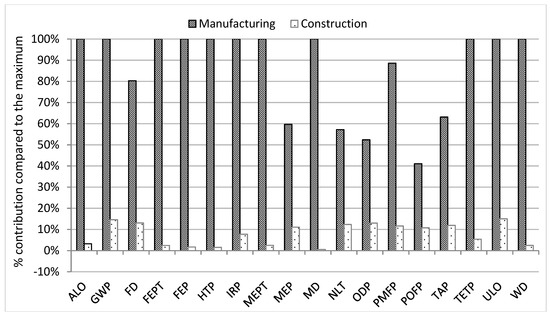
Figure 5.
Impact categories of manufacturing and construction stage.
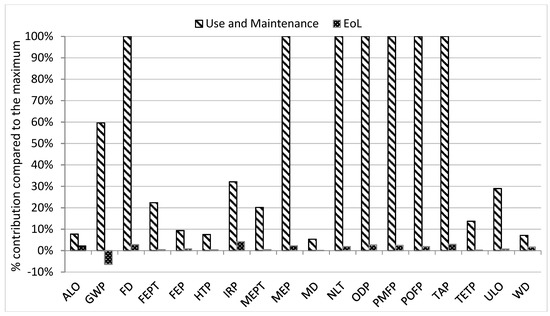
Figure 6.
Impact categories of use and end of life stage.
Another type of information that can be obtained by the midpoint approach is the contribution of the different products or processes to each impact category. For illustrative purposes, only three of the most popular impact categories (GWP, OD and PMF) will be studied more exhaustively and will display the contribution of the different products or processes to each bridge life-cycle phase. Figure 7, Figure 8, Figure 9 and Figure 10 show the contributions of the most important processes for each bridge life-cycle phase. Figure 7 corresponds to the manufacturing phase and it is possible to see that the most important associated processes are the cement production, steel production and transport. Cement production makes the highest contribution to the GWP, namely 46.49% of the total but in the PMF and OD categories, steel production has the higher ratio with percentages of 76.14 and 57.44% respectively. Furthermore, it can be seen that, although the GWP has a low percentage of other processes (6.07%), the cement production, steel production and transport represent a larger part of the environmental impact of this bridge life-cycle phase. Figure 8 corresponds to the construction phase and the processes that lead to practically all the environmental impacts are those due to the manipulation of fresh concrete and the transport and elevation of the precast beams. Figure 9 and Figure 10 show the use and maintenance phase and end-of-life phase, in which the CO2 fixed is taken into account. In the GWP impact category, it can be seen that there is a positive impact. On one hand, in the use and maintenance phase, the amount of CO2 fixed is much lower than the CO2 eq produced by the maintenance activities and the traffic detour because the concrete surface in contact with the environment represents a very low proportion of the total of amount of concrete in the bridge. The percentage of the CO2 fixed is −3.84%, while the percentages of maintenance activities and traffic detour are 89.95% and 13.89%, respectively, adding a total of 100% due to that the global GWP impact in this phase is positive. The ratio of the contribution of the maintenance activities and traffic detour can be modified considerably in function of the features of the traffic diversion (distance, average daily traffic and percentage of trucks). On the other hand, in the end-of-life phase, the amount of CO2 fixed is higher (−254.05%) than the CO2 eq produced by the demolition activities (22.40%), the waste treatment (36.21%) and the associated transport (96.18%). The total contribution of the processes in the end-of-life phase is negative, adding a total of −100%. In the other impact categories (PMF and OD), the maintenance activities and transport make the major contribution to each bridge life-cycle.
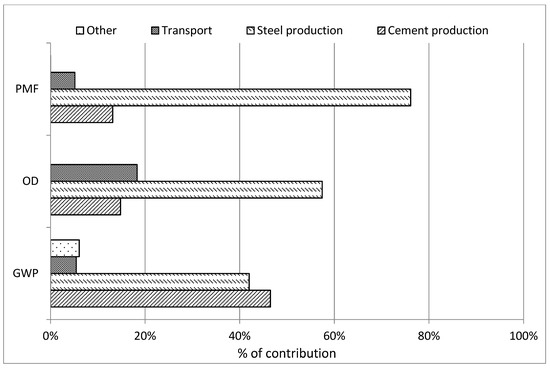
Figure 7.
Manufacturing phase.

Figure 8.
Construction phase.
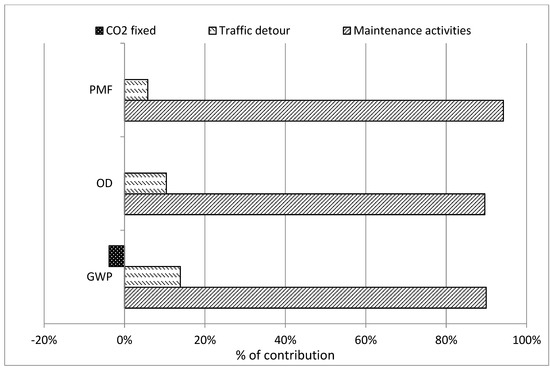
Figure 9.
Use and maintenance phase.
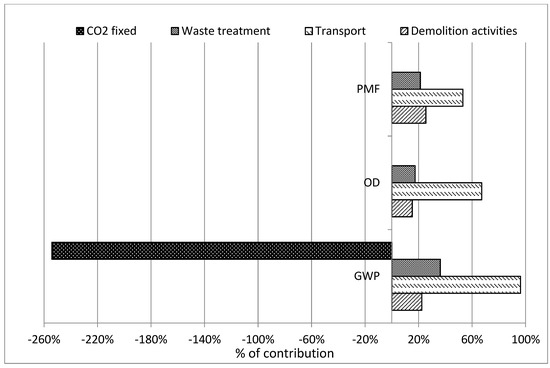
Figure 10.
End-of-life phase.
Endpoint Approach
Despite the large amount of information obtained by means of the midpoint approach, it is very difficult to obtain a global environmental impact assessment. For this purpose, the endpoint approach is more useful. This approach provides only three damage categories (human health, resources and ecosystem), which are easier to interpret. Table 4 shows the mean and coefficient of variance of the three damage categories. Although the reference unit of the different damage categories remains different, carrying out the normalization and weighting of three categories is easier than doing so for 18 categories. In fact, ReCiPe allows the normalization of the three damage categories by converting the reference unit of each damage category into points. That makes it easier to interpret the global environment assessment of the bridge. Figure 11 shows the normalized value of each damage category of the whole life-cycle of the bridge and Figure 12 displays the contribution of each phase considering that the different damage categories have the same importance. On one hand, Figure 11 shows that human health is the most important damage category, followed by resources and ecosystem. On the other hand, in Figure 12 the contribution of different phases using the endpoint approach can be seen. The manufacturing phase is the phase with the highest contribution to the bridge life-cycle, followed by the use and maintenance phase and both the construction phase and the end-of-life phase make very low contributions compared to the other two phases.

Table 4.
Endpoint approach.
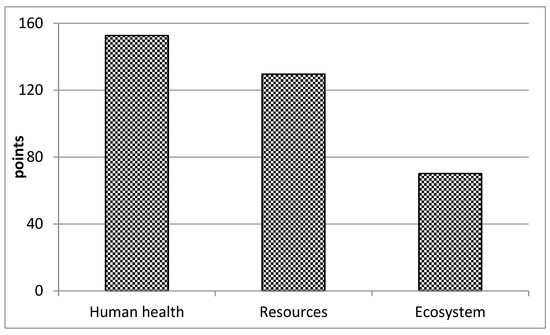
Figure 11.
Damage categories.
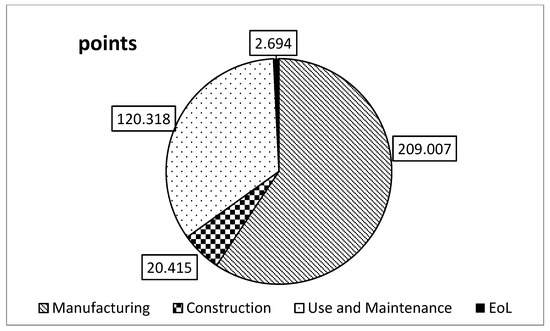
Figure 12.
Contribution of bridge life-cycle phases.
5. Conclusions
Reduction of the environmental impact is a trend that must be taken into account due to the environmental problems that exist nowadays. In this respect, the construction sector has a large margin for improvement. The design of structures or buildings must consider the aspects of three pillars of sustainability. The assessment of the environmental impact during the whole life is a factor that must be taken into account in the design of structures or buildings. Although CO2 emissions are not the only indicator to be considered in the environmental assessment, due to the relationship of this indicator with the cost, it is used to obtain a bridge with the lowest cost and a low environmental impact. Once this bridge has been obtained, a complete environmental assessment is carried out. For this purpose, a heuristic optimization by means of a hybrid memetic algorithm is used to obtain a cost-optimized prestressed concrete precast bridge and thus a low amount of associated CO2. Then, the midpoint and endpoint approaches of the ReCiPe method are used to obtain a complete environmental profile of the bridge. These different approaches make it possible to obtain complementary data that provide different information. While the midpoint approach provides detailed information, the endpoint approach provides more concentrated information so it is possible to obtain only one score to assess all the environmental impacts.
Regarding the results of the midpoint approach, the manufacturing phase and use and maintenance phase are the phases with the higher environmental impact. With this knowledge, it is interesting to determine the processes that make the biggest contributions in these phases to try to reduce the environmental impact. Cement production and steel production are the processes with the highest environmental impact in the manufacturing phase, while the maintenance activities have the most environmental impact in the use and maintenance phase. Therefore, the midpoint approach indicates the process with the highest contribution in each impact category and in this way, it is possible to know which process to modify depending on the impact category to be improved. The midpoint approach provides detailed information but does not offer a single score that represents the global environmental impact of the bridge. For this purpose, the endpoint approach is used. As can be deduced, in the midpoint approach, the manufacturing phase and the use and maintenance phase are the ones with the higher environmental impact.
After studying both the midpoint and endpoint approaches, the results show the need for a complete environmental profile to evaluate the environmental impact of the bridge. The midpoint approach provides information that makes it possible to identify the processes in which improvements should be carried out to improve specific impact categories of the bridge but the endpoint approach provides a single score that is able to evaluate the global environmental impact of the bridge. Furthermore, although CO2 emissions are an important indicator in the environmental impact assessment, in some cases it is not sufficient to obtain an accurate environmental evaluation and it is necessary to take into account all the other impact categories.
Acknowledgments
The authors acknowledge the financial support of the Spanish Ministry of Economy and Competitiveness, along with FEDER funding (Project: BIA2017-85098-R).
Author Contributions
This paper represents a result of teamwork. The authors jointly designed the research. Vicent Penadés-Plà drafted the manuscript. Tatiana García-Segura, José V. Martí and Víctor Yepes edited and improved the manuscript until all authors are satisfied with the final version.
Conflicts of Interest
The authors declare no conflict of interest.
References
- United Nations. World Commission on Environment and Development Our Common Future; United Nations: New York, NY, USA, 1987. [Google Scholar]
- Waas, T.; Hugé, J.; Block, T.; Wright, T.; Benitez-Capistros, F.; Verbruggen, A. Sustainability Assessment and Indicators: Tools in a Decision-Making Strategy for Sustainable Development. Sustainability 2014, 6, 5512–5534. [Google Scholar] [CrossRef]
- Penadés-Plà, V.; García-Segura, T.; Martí, J.; Yepes, V. A review of multi-criteria decision-making methods applied to the sustainable bridge design. Sustainability 2016, 8, 1295. [Google Scholar] [CrossRef]
- Zavadskas, E.K.; Antucheviciene, J.; Vilutiene, T.; Adeli, H. Sustainable decision making in civil engineering, construction and building technology. Sustainability 2018, 10, 14. [Google Scholar] [CrossRef]
- Yepes, V.; Martí, J.V.; García-Segura, T. Cost and CO2 emission optimization of precast-prestressed concrete U-beam road bridges by a hybrid glowworm swarm algorithm. Autom. Constr. 2015, 49, 123–134. [Google Scholar] [CrossRef]
- Camp, C.V.; Assadollahi, A. CO2 and cost optimization of reinforced concrete footings using a hybrid big bang-big crunch algorithm. Struct. Multidiscip. Optim. 2013, 48, 411–426. [Google Scholar] [CrossRef]
- García-Segura, T.; Yepes, V.; Martí, J.V.; Alcalá, J. Optimization of concrete I-beams using a new hybrid glowworm swarm algorithm. Lat. Am. J. Solids Struct. 2014, 11, 1190–1205. [Google Scholar] [CrossRef]
- García-Segura, T.; Yepes, V. Multiobjective optimization of post-tensioned concrete box-girder road bridges considering cost, CO2 emissions, and safety. Eng. Struct. 2016, 125, 325–336. [Google Scholar] [CrossRef]
- García-Segura, T.; Yepes, V.; Frangopol, D.M. Multi-objective design of post-tensioned concrete road bridges using artificial neural networks. Struct. Multidiscip. Optim. 2017, 56, 139–150. [Google Scholar] [CrossRef]
- Laurent, A.; Olsen, S.I.; Hauschild, M.Z. Limitations of carbon footprint as indicator of environmental sustainability. Environ. Sci. Technol. 2012, 46, 4100–4108. [Google Scholar] [CrossRef] [PubMed]
- Du, G.; Karoumi, R. Life cycle assessment of a railway bridge: Comparison of two superstructure designs. Struct. Infrastruct. Eng. 2012, 9, 1149–1160. [Google Scholar] [CrossRef]
- Du, G.; Safi, M.; Pettersson, L.; Karoumi, R. Life cycle assessment as a decision support tool for bridge procurement: Environmental impact comparison among five bridge designs. Int. J. Life Cycle Assess. 2014, 19, 1948–1964. [Google Scholar] [CrossRef]
- Hammervold, J.; Reenaas, M.; Brattebø, H. Environmental life cycle assessment of bridges. J. Bridge Eng. 2013, 18, 153–161. [Google Scholar] [CrossRef]
- Pang, B.; Yang, P.; Wang, Y.; Kendall, A.; Xie, H.; Zhang, Y. Life cycle environmental impact assessment of a bridge with different strengthening schemes. Int. J. Life Cycle Assess. 2015, 20, 1300–1311. [Google Scholar] [CrossRef]
- Zastrow, P.; Molina-Moreno, F.; García-Segura, T.; Martí, J.V.; Yepes, V. Life cycle assessment of cost-optimized buttress earth-retaining walls: A parametric study. J. Clean. Prod. 2017, 140, 1037–1048. [Google Scholar] [CrossRef]
- Penadés-Plà, V.; Martí, J.V.; García-Segura, T.; Yepes, V. Life-cycle assessment: A comparison between two optimal post-tensioned concrete box-girder road bridges. Sustainability 2017, 9, 1864. [Google Scholar] [CrossRef]
- Ecoinvent Center Ecoinvent v3.3. 2016. Available online: http://www.ecoinvent.org/database/older- versions/ecoinvent-33/ecoinvent-33.html (accessed on 15 January 2018).
- Goedkoop, M.; Heijungs, R.; Huijbregts, M.; Schryver, A.D.; Struijs, J.; Van Zelm, R. ReCiPe 2008. A Life Cycle Impact Assessment Which Comprises Harmonised Category Indicators at Midpoint and at the Endpoint Level; Ministerie van Volkshuisvesting, Ruimtleijke Ordening en Milieubeheer: Den Haag, The Netherlands, 2009; Available online: https://www.researchgate.net/profile/Mark_Goedkoop/publication/230770853_Recipe_2008/links/09e4150dc068ff22e9000000.pdf (accessed on 15 January 2018).
- Cohn, M.Z.; Dinovitzer, A.S. Application of structural optimization. J. Struct. Eng. 1994, 120, 617–650. [Google Scholar] [CrossRef]
- Blum, C.; Puchinger, J.; Raidl, G.R.; Roli, A. Hybrid metaheuristics in combinatorial optimization: A survey. Appl. Soft Comput. 2011, 11, 4135–4151. [Google Scholar] [CrossRef]
- Martí, J.V.; García-Segura, T.; Yepes, V. Structural design of precast-prestressed concrete U-beam road bridges based on embodied energy. J. Clean. Prod. 2016, 120, 231–240. [Google Scholar] [CrossRef]
- International Organization for Standardization (ISO). Environmental Management—Life Cycle Assessment—Principles and Framework; ISO: Geneva, Switzerland, 2006. [Google Scholar]
- Yi, S.; Kurisu, K.H.; Hanaki, K.; Hanaki, K. Life cycle impact assessment and interpretation of municipal solid waste management scenarios based on the midpoint and endpoint approaches. Int. J. Life Cycle Assess. 2011, 16, 652–668. [Google Scholar] [CrossRef]
- European Committee. European Committee for Standardization EN 206-1 Concrete—Part1: Specification, Performance, Production and Conformity; European Committee: Brussels, Belgium, 2000. [Google Scholar]
- Ministerio de Fomento. EHE-08: Code on Structural Concrete; Ministerio de Fomento: Madrid, Spain, 2008. [Google Scholar]
- Ministerio de Fomento. IAP-11: Code on the Actions for the Design of Road Bridges; Ministerio de Fomento: Madrid, Spain, 2011. [Google Scholar]
- Moscato, P. On Evolution, Search, Optimization, Genetic Algorithms and Martial Arts—Towards Memetic Algorithms; California Institute of Technology: Pasadena, CA, USA, 1989. [Google Scholar]
- Dawkins, R. The Selfish Gene; Claarendon Press: Oxford, UK, 1976. [Google Scholar]
- Catalonia Institute of Construction Technology. BEDEC PR/PCT ITEC Material Database 2016. Available online: https://www.itec.cat/nouBedec.c/bedec.aspx (accessed on 15 January 2018).
- García-Segura, T.; Yepes, V.; Frangopol, D.M.; Yang, D.Y. Lifetime reliability-based optimization of post-tensioned box-girder bridges. Eng. Struct. 2017, 145, 381–391. [Google Scholar] [CrossRef]
- Lagerblad, B. Carbon Dioxide Uptake during Concrete Life Cycle—State of the Art; Cement och Betong Institutet: Stockholm, Sweeden, 2005. [Google Scholar]
- García-Segura, T.; Yepes, V.; Alcalá, J. Life cycle greenhouse gas emissions of blended cement concrete including carbonation and durability. Int. J. Life Cycle Assess. 2014, 19, 3–12. [Google Scholar] [CrossRef]
- Frischknecht, R.; Jungbluth, N.; Althaus, H.-J.; Doka, G.; Dones, R.; Heck, T.; Hellweg, S.; Hischier, R.; Nemecek, T.; Rebitzer, G.; et al. The ecoinvent database: Overview and methodological framework. Int. J. Life Cycle Assess. 2005, 10, 3–9. [Google Scholar] [CrossRef]
- Ciroth, A.; Muller, S.; Weidema, B.; Lesage, P. Empirically based uncertainty factors for the pedigree matrix in ecoinvent. Int. J. Life Cycle Assess. 2016, 21, 1339–1348. [Google Scholar] [CrossRef]
- Itoh, Y.; Kitagawa, T. Using CO2 emission quantities in bridge lifecycle analysis. Eng. Struct. 2003, 25, 565–577. [Google Scholar] [CrossRef]
- Bouhaya, L.; Le Roy, R.; Feraille-Fresnet, A. Simplified environmental study on innovative bridge structure. Environ. Sci. Technol. 2009, 43, 2066–2071. [Google Scholar] [CrossRef] [PubMed]
© 2018 by the authors. Licensee MDPI, Basel, Switzerland. This article is an open access article distributed under the terms and conditions of the Creative Commons Attribution (CC BY) license (http://creativecommons.org/licenses/by/4.0/).